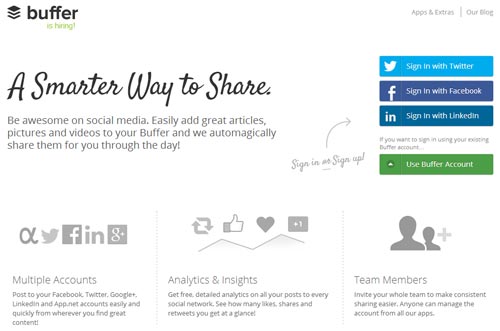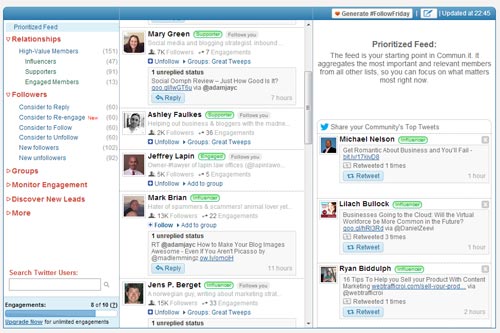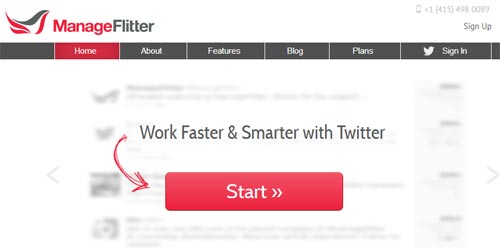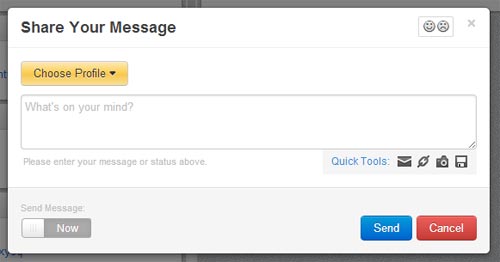Social media management can be overwhelming. Adam Connell did a great job summarizing the pros and cons of the top tools used today.
Jeff
13 Best Social Media Management Tools
In
the following post you’re going to discover some of the most powerful
social media tools on the market. These will help you save more time
managing your social accounts, pull out actionable insights about
influencers and ultimately help you get results.
Social media has some huge benefits, you can use it to
promote your content and you can use it to
connect with influencers.
That’s great, but when you’ve got various profiles across a number of
different social networks, managing them can become extremely time
consuming.
What if you could find a way to save an incredible amount of time,
connect with more influencers than before and ultimately get more from
your social media marketing efforts?
The collection of tools that I’ve put together for you are the answer
– all of them are extremely powerful and have some great features.
Hold on to your hats …
Top Social Media Management Tools
Social Oomph (Free + $)

Sure, it doesn’t look pretty but it doesn’t need to be. Social Oomph gets the job done.
Social Oomph will take your productivity to the next level with
advanced scheduling, integrated timelines, click tracking, advanced
methods of combatting Twitter spam, support for Facebook and Linkedin
along with support for unlimited accounts.
You can even manage multiple blogs right from your account which
means managing your blogs can be done easily. Social Oomph supports a
number of different platforms from
free blogging platforms to self-hosted WordPress installations.
There are free and paid accounts available, but you really need the
paid account to make the most of it, pricing starts at around $26 per
month and you will never need to pay any more than that no matter how
many accounts you use.
I have a paid account and it saves me loads of time, it’s an integral part of my social media toolbox.
Sign up for an account | Read the review
Buffer (Free + $)

Buffer makes scheduling status updates so easy.
The annoying thing about pressing the tweet button or publishing an
update on most social platforms is that it goes out straight away, not
when you want.
Sometimes you want to share a few posts but if you share them all at
the same time then chances are you’ll annoy your followers – Buffer
allows you to spread them out how you want.
Just add an update to your Buffer and they will be published at pre-determined times which you can change to whatever you like.
The great news here is that Buffer is now compatible with Google+ pages which isn’t supported by many platforms (yet).
There’s also helpful analytics and the option to setup team members.
The ‘Awesome’ account as they call it, starts at $10/month.
Sign up for an account
Hootsuite (Free + $)

Hootsuite is the tool that I use for my day to day management of my social media accounts.
It makes responding and updating profiles really easy and their mobile app makes things pretty easy when I’m on the go.
The free account limits you to 5 social profiles, gives you basic
scheduling and reporting but the real good stuff happens when you get on
the pro account.
The pro account allows you to monitor and update over 50 social profiles along with some other helpful features.
You can also import unlimited RSS feeds to your social profiles and
while you are better off doing things manually, this is a quick way to
keep your profiles updated if you are short on time.
The free account may do what you need, but it’s well worth giving
their 30 day pro account free trial a go to see what you think, if you
like it then it’s only $8.99 a month.
Sign up for a 30 day pro account free trial
Tweepi (Free + $)

The way that Tweepi can help you is by giving you the ability to
clean up your account and figure out who to follow, who to unfollow etc.
The unfortunate part is that you can’t really do all that much with
the free account, all the good stuff is part of the premium account (as
you’d expect).
Premium accounts start at $7.99 per month but the data you’ll be able to get back more than makes up for it.
You’ll be able to make decisions based on Klout score, verified
accounts, protected, location, # followers, # statuses, follow ratio and
clean up all those accounts with the egg display picture.
Sign up for an account
Commun.it (Free + $)

Commun.it is unlike any other Twitter management tool I have ever come across.
It is geared towards helping you engage with influencers which is awesome because
Influencer Marketing is huge but what really makes this platform great is that it tells you what to do next.
The free account is quite limited however, but it’s still incredibly useful.
Pricing starts from around $30 if you’re paying monthly which allows
you to add 4 profiles and have unlimited engagements – if you need more
then there are a few other accounts that add other helpful features.
Sign up for an account
Manage Flitter (Free+ $)

Manage Flitter is focused mostly on Twitter as opposed to the likes
of Social Oomph and Hootsuite that offer a more complete social media
management solution.
That being said, Manage Flitter has some extremely useful features
that highlight who to follow and who to unfollow. For example, are you
following fake profiles? Manage Flitter will tell you.
You can also use Manage Flitter to import your Google+ posts to Twitter.
One feature that really jumps out at me is the ‘Power Post’ feature that allows you to post updates at the best times.
You can add different pieces of data and overlay it on a time line so you can visually see when the best time to post is.
Types of data you can add boils down to when particular segments of
people are on Twitter, you can add particular locations, people you
follow and the pro account allows you to add your followers which is
incredibly useful.
Sign up for an account
Market Me Suite (Free +$)

While Manage Flitter focuses more on Twitter, Market Me Suite is a
different kettle of fish (so to speak) it’s positioned as more of a
complete social media management tool.
Plans start from free but you’re restricted to 1 profile and only a
few scheduled messages although if that’s enough for you then I’m sure
you’ll find some of the features interesting.
The pro plan starts at $15 per month and lifts the limit on profiles and adds team members, analytics and other add ons.
The way Market Me Suite works isn’t as much about ‘personal’ social
media use but using social media for generating business leads.
Sign up for an account
TweetDeck (Free)

TweetDeck is pretty awesome and it’s completely free; providing you
an easy to use tool that you can use to monitor and manage unlimited
accounts, schedule tweets and more.
There is a mobile app too so staying updated on the go is extremely easy.
Despite this being a tool owned by Twitter it also integrates Facebook too.
On a personal note, I do prefer the feel of Hootsuite (maybe that’s
because I’m so used to it) but TweetDeck does seem to deliver more data
in your Twitter feed, including who’s followed you etc.
Learn more here
Raven Tools ($)

Raven Tools comes in at a higher starting price point ($99 p/month)
but you get so much more because this is a complete marketing toolset
that includes in depth research tools, rank tracking, PPC management,
SEO and social media management tools.
I won’t go too much into the other features here (please note, they are awesome) since we’re talking more about social media.
Raven Tools is currently compatible with Twitter, Facebook and
YouTube – it includes a monitoring tool that pulls in mentions from
search results across a bunch of different platforms, so if you’re
looking for an alternative to Google Alerts too, then this is the tool
for you.
There’s even some really useful reporting functionality that pull in metrics from Twitter, Facebook and YouTube.
Raven Tools is team friendly and also has a built in CRM and task
management system – the Swiss army knife of marketing platforms.
Sign up for the 30 day free trial
Sprout Social ($)

Sprout Social is a comprehensive social media marketing platform that puts all of your social profiles in one place.
There’s a task management system built in to make tracking what you’re doing easy, especially if you’re working with teams.
Sprout Social has put a lot of thought into scheduling, similar to
Buffer there is a ‘Sprout Queue’ that you can add updates to that will
filter out whenever you like.
You’ve got all the usual search and profile clean up options that a
lot of other social media management tools (especially those that focus
on Twitter) have these days.
Supported social platforms include the following:
- Twitter
- Facebook
- Google+ Pages
- Linkedin
Along with integration for RSS feeds and Google Analytics.
Sign up here
Social Bro ($)

Social Bro currently just supports Twitter but it brings you the complete package that allows you to;
- Target the right people
- Engage with the right people
- Analytics and tracking
- Twitter management
There is so much to this tool that you really need to sign up to their free trial to see exactly what it can do.
A few other interesting features include Hootsuite integration and their ‘best time to tweet’ function.
Overall, Social Bro starts at a lower price point than most tools, but it does have a few restrictions
Sign up for the 15 day free trial
Social Motus ($)

Social Motus is a complete social marketing platform that will help you manage your Facebook and Twitter profiles.
You’ll also be able to schedule posts, find highly targeted prospects and track the success of your marketing campaigns.
You can also monitor your blog or brand name to see what is being said – great for reputation management.
Sign up for an account here
Sendible ($)

The problem with a lot of social media management tools is that they
only support a few services, what If I could show you a tool that allows
you to manage a huge number of social platforms easily?
It’d be great right?
Well, say hello to Sendible!
Here are a few of the social media sites that Sendible supports:
- Facebook
- Google+
- Linkedin
- Twitter
- Flickr
- Ning
- Instagram
- Foursquare
- Delicious
- Diigo
- Instapaper
- Tumblr
- Blogspot
- WordPress
- WordPress.com
- Typepad
… The list continues.
In addition to being able to manage the above platforms you can also
measure the success of everything you publish, monitor, respond and
more.
There’s also built in support for an SMS auto responder and a number of free email services along with more cool stuff.
Sounds good right?
Pricing starts at around $15.
Sign up for the 30 day free trial
Rounding up …
Now you’ve had a good look at what social media management tools are
available on the market, I hope you can come to a good decision to
really make your mark on social media.
The tools I’ve listed incorporate a good mix of tools that do other awesome things, especially the likes of
Raven Tools that will turn you and your blog into a marketing powerhouse with all the tools you’ll need to succeed.
And right down to straight up productivity tools that enable you to get more from social such as
Social Oomph.
So now my question to you is – what do you find difficult about managing your social media accounts?
















